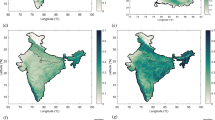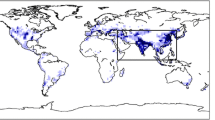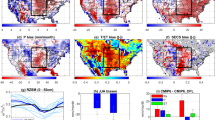Abstract
A vast number of weather forecast and climate models have a common warm-and-dry bias, accompanied by the underestimation of evapotranspiration and overestimation of surface net radiation, over the central United States during boreal summer. Various theories have been proposed to explain these biases, but no studies have linked the biases with the missing representation of human perturbations, such as irrigation. Here we argue that neglecting the impact of irrigation contributes to the longstanding warm surface temperature and lack of precipitation biases over this region. By using convection-permitting multi-season simulations over the contiguous United States coupled with an operational-like irrigation scheme, we show that irrigation increases surface evapotranspiration and decreases surface temperature by increasing evaporative fraction. By increasing the frequency of mesoscale convective systems, irrigation reduces the summertime model precipitation deficit and improves the simulated precipitation diurnal cycle over the Great Plains. The increased precipitation also alleviates the warm bias in our simulation setup, likely by dam** the positive feedback between soil moisture and temperature.
Similar content being viewed by others
Introduction
In spite of continued improvements in the representation of physical processes and the unrelenting increase in spatial resolution, climate models still suffer from persistent biases in a number of key variables including precipitation and temperature. One particular bias common in a vast number of weather forecast and climate models is a too warm lower troposphere over the central United States1,2,Full size image
Convective Available Potential Energy (CAPE), a measure of the amount of energy available for convection, is an indicator of atmospheric instability in predicting intensity of convection by quantifying the uplift potential of an air parcel. In general, increased moisture at low levels increases CAPE, increasing the likelihood of convective precipitation40,41,42. In contrast, a cooler land surface may enhance convective inhibition (CIN), suppressing the initiation of deep convection25,40,43,44. By decreasing surface temperature and increasing moisture, irrigation contributes to competing effects on the development of convection at local scales over the irrigated areas (Fig. 5). Downwind of the irrigated region over the Midwest, there is clear evidence of increased LCL crossing throughout the afternoon along with decreased CIN, which favors convective initiation and explains the increased late-afternoon isolated convection frequency over the northern Great Plains (Figs. 4b and 5). More frequent late-afternoon convective initiation, along with more favorable thermodynamic conditions (increased CAPE and a moister boundary layer) results in more upscale growth of isolated convection to form MCSs during early evening hours (Fig. 2). The thermodynamic environmental changes (Fig. 5) are spatially coherent with the increased daily average precipitation (see Supplementary Fig. 3). CAPE, CIN, and LCL crossing during the morning and the middle of the day are also examined, and we find spatially consistent changes similar to those in late-afternoon hours (Supplementary Figs. 4 and 5).
Irrigation impact on temperature
Most contemporary global climate and weather forecasting models exhibit a large systematic warm bias during the summertime over the Great Plains1,2,49, is incorporated and regridded to the model grid (4 km grid spacing). For a model grid cell to be possibly irrigated, the land cover type needs to be cropland or pastures with irrigation fraction greater than zero.
Irrigation is triggered only during the growing season (April–October) when soil MA is below a certain threshold. Growing season is defined such that green vegetation fraction (GVF) needs to be greater than a threshold (GVFthresh) defined following the equation:
where GVFmin and GVFmax are the minimum and maximum monthly GVF based on MODIS climatological value. During growing seasons, irrigation will be triggered when root zone soil moisture availability (MA) is <0.5. The moisture availability is defined as follows:
where SM is the soil moisture content, SMFC and SMWP are the soil moisture field capacity and wilting point, respectively.
The amount of water irrigated is calculated as the difference between soil moisture holding capacity and current soil moisture content over the soil column at the time when irrigation is triggered. Then, irrigated water is distributed evenly and behaves like precipitation to mimic sprinkler irrigation through a 4 h time window starting from 0600 to 1000 LT.
Observations
The observations used to identify MCSs in this study are similar to those used by Feng et al.29. The 3D mosaic Next-Generation Radar radar reflectivity dataset over CONUS is obtained from the National Severe Storm Laboratory Multi-Radar Multi-Sensor (MRMS) system50. The MRMS 3D radar reflectivity has spatiotemporal resolution of 1 and 5 min, respectively. Quantitative precipitation estimates using high-resolution (1 km) mosaic radar data with rain gauge network bias correction, known as the Q2 precipitation product (obtained from https://www.nssl.noaa.gov/projects/mrms/), are also available every hour. The merged geostationary satellite brightness temperature (Tb) data51 (https://doi.org/10.5067/P4HZB9N27EKU) are obtained from the NASA Goddard Earth Sciences Data and Information Services Center. The satellite dataset has spatiotemporal resolution of 4 km and 30 min, respectively. The MRMS 3D radar and Q2 datasets are regridded to match the satellite 4 km grid every hour, which is used to track MCSs. A second high-resolution precipitation product from the Stage-IV multi-sensor precipitation dataset (https://doi.org/10.5065/D6PG1QDD) is also used in this study. The Stage-IV precipitation is produced by the 12 River Forecast Centers in the continental United States, available at 4 km every hour52.
MCS tracking
Long-lived and intense MCSs are tracked using the FLEXTRKR algorithm described in detail by Feng et al.29. FLEXTRKR uses Tb to identify and track large cold-cloud systems associated with deep convection, and further identifies MCS based on the duration, size and intensity of the radar echo signatures. MCS is defined as a cold-cloud system that exceeds a horizontal area of 60,000 km2, with a precipitation feature extending longer than 100 km in any direction, and an embedded convective radar echo stronger than 50 dBZ. All of these criteria must be met continuously for longer than 6 h. These convective systems are designated as long-lived and intense MCSs, and they account for 46% of observed warm-season total rainfall in 201129. The same criteria were applied to the model simulated radar reflectivity and outgoing longwave radiation, which was converted to equivalent Tb, for consistent MCS identification and tracking.
GCMs and reference dataset
The GCM simulations are from the fifth phase of the CMIP553 Atmospheric Model Intercomparison Project experiment. Thirty model simulations are obtained from the Earth System Grid Federation (https://esgf-node.llnl.gov/projects/esgf-llnl/). Only one ensemble member (r1i1p1) from each model is used. The observed monthly 2 m air temperature is station data from the University of Delaware Air Temperature version 554. All data are interpolated onto 1° × 1° horizontal degree.




